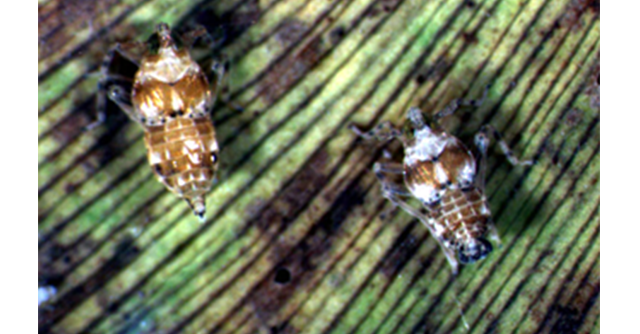Researching New Biocontrol Agents for Water Hyacinth

Physiological studies can provide valuable information to ensure the success of a biocontrol agent. For instance, the relationship between herbivores and their host plants often involves a mutual dependency (symbiotic associations) with different microorganisms, often called endosymbionts.
The water hyacinth planthopper, Megamelus scutellaris, an important biocontrol agent of water hyacinth, has endosymbionts to make up for deficiencies in the plant hopper’s diet, meaning they can have a strong impact on the establishment of the planthopper.
This insect does well in some introduction areas, and not so well in others, notably in Florida, where it was first introduced.
One of the hypothesis is that this is due to climatic adaptability and/or endosymbiont composition. Scientists from Foundation for the Study of Invasive Species (FuEDEI) and La Plata University are studying variables related to climate change, particularly the increase in CO2 concentration and temperature, and how they affect endosymbionts, indirectly impacting the insect's fitness.
Recently, the Invasive Plant Research Laboratory in Fort Lauderdale, Florida, has resumed research on water hyacinth with FuEDEI, hoping to introduce new biocontrol agents, and find ways to improve the effect of M. scutellaris.
In time, populations of the water hyacinth plant hopper with a “healthy” endosymbiont provision could be introduced in areas found to have lower establishment success, thus making biocontrol more efficient.
In addition to biocontrol agents, FuEDEI scientists are also identifying and testing chemical signals that attract target insects (such as semiochemicals) that can be used in developing monitoring systems and development of management strategies including trap crops, mating disruption techniques, and attractant toxic baits.
Author: Guillermo Cabrera Walsh, gcabrera@fuedei.org
The Foundation for the Study of Invasive Species (FuEDEI), formerly known as the South American Biological Control Laborator, is located in Hurlingham, Argentina, near Buenos Aires. FuEDEI plays a crucial role collecting and providing candidate biological control agents for South American weeds and pest insects for federal and state cooperators, several U.S. universities, and research collaborators worldwide since 1962. FuEDEI’s main mission includes exploring for natural enemies of target insects and weeds in Argentina and neighboring countries and conducting host-specificity testing to determine their safety for eventual release in the U.S. In addition, complementary research that investigates the ecology, behavior, taxonomy, and genetic differences based on geographic distribution is conducted on both targets and potential agents. Performing these studies in the region of origin of the target pest serves as an efficient prescreening process that reduces the number of biocontrol agent candidates shipped. This reduces the amount of quarantine work and valuable quarantine space occupation, the expenses related to permitting processes, the risks of escapes, and the release of maladapted or wrongly identified agents to a minimum, saving in costs and hazards. On some occasions these complementary studies help us understand why an exotic organism becomes invasive, which can, in turn, lead to determining novel strategies for their management.
